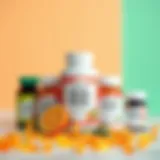Top Chemical Peels for Skin Discoloration Explained


Intro
Skin discoloration can feel like an unwelcome guest, overstaying its welcome and making even the simplest skincare routines seem like a complex puzzle. Whether it's sun spots, melasma, or post-acne marks, uneven skin tone can impact not only one's appearance but also self-confidence. The good news? Chemical peels offer a way to tackle these pesky issues, unveiling a more radiant complexion beneath.
This article dives into the world of chemical peels, focusing on those specifically designed to address discoloration. It's not merely about slapping on a product and hoping for the best; understanding the options available, how they work, and their potential benefits is crucial. This isn’t a one-size-fits-all scenario; factors such as skin type, specific concerns, and overall skin health matter deeply when considering any treatment.
By exploring various chemical peels, from professional treatments in a dermatologist's office to options that can be safely used at home, readers will gain a well-rounded perspective on their choices. After all, knowledge is power—especially when it comes to skincare. So, buckle up as we navigate through the ins and outs of chemical peels and their impact on skin discoloration.
Intro to Chemical Peels and Discoloration
Understanding chemical peels is essential for those wanting an effective solution to skin discoloration. These treatments not only address uneven skin tones but also contribute to overall skin health. Discoloration can manifest in various forms, such as dark spots, melasma, or post-acne marks, affecting people regardless of age or skin type. In this introduction, we delve into the significance of chemical peels, highlighting how they work in tandem with skin's natural recovery mechanisms.
Chemical peels act as a catalyst for skin renewal. By removing the outermost layers of the skin, they expose a fresh, regenerated layer underneath. This process can drastically improve the appearance of discoloration by promoting a more uniform skin tone.
There are distinct advantages to considering chemical peels for discoloration. They can enhance skin texture, stimulate collagen production, and improve the absorption of skincare products. Moreover, the recovery period for many chemical peels is minimal, making them an appealing option for those with hectic lifestyles.
However, several considerations come into play. Not all chemical peels are created equal, and the best choice depends on individual skin conditions and goals. Understanding the nuances between types of peels—superficial, medium-depth, and deep—along with their active ingredients is critical. Failure to do so can result in suboptimal results or even adverse effects.
In essence, the journey through chemical peels is not just about aesthetics. It involves a holistic approach to skin health, catering to individual needs while balancing potential risks and benefits.
Experience and knowledge are invaluable. With the right information, women of all ages can navigate their options, making informed decisions that align with their beauty goals. As we progress through this article, we'll explore the causes of discoloration, the types of chemical peels available, and what to consider for optimal results.
"Knowledge is power. When it comes to your skin, being well-informed can be the difference between a fleeting solution and lasting results."
By gaining insight into the world of chemical peels, you're already on the road to a healthier, more radiant complexion.
What Causes Skin Discoloration?
Skin discoloration is a common concern that transcends age, ethnicity, and skin type. Understanding the root causes of discoloration can help individuals make informed decisions about treatments and preventative measures. By delving into the factors that contribute to uneven skin tone, one starts to comprehend how various external and internal influences impact skin health. This understanding is particularly important for anyone considering chemical peels, as tailoring the treatment to specific types of discoloration can yield the best results.
Types of Skin Discoloration
Skin discoloration generally appears in varying shades and patterns, often reflecting a person's individual experiences and habits. Here are several notable types:
- Hyperpigmentation: This condition occurs when certain areas of the skin become darker than the surrounding skin due to excess melanin production, often triggered by sun exposure or hormonal changes.
- Hypopigmentation: Opposite to hyperpigmentation, this condition involves patches of skin becoming lighter, which can result from conditions like vitiligo or post-inflammatory changes.
- Uneven skin tone: A combination of dark and light patches resulting from various factors can give one’s skin a tired and uneven appearance.
These types can overlap, and understanding them helps in choosing appropriate treatments that target specific issues more effectively.
Factors Contributing to Discoloration
Understanding the factors contributing to skin discoloration sheds light on how to address and manage these changes.
Sun exposure
Sun exposure can be a double-edged sword; while many people enjoy basking in the sun, it poses serious risks for the skin. Ultraviolet rays can trigger an increase in melanin production as a natural defense mechanism, leading to spots and uneven skin tone. This makes sun exposure a key player in conditions like melasma and solar lentigines.
The key characteristic of sun exposure is its cumulative effect over time. Simply put, the more time spent in the sun without protection, the more likely skin will show signs of discoloration.
While some sun exposure is beneficial—providing essential Vitamin D—overexposure is a definitive disadvantage. Therefore, wearing sunblock is crucial; it acts as a barrier against harmful effects and helps maintain an even skin tone.
Hormonal changes
Hormonal changes can throw a wrench into the smooth sailing of your skin’s appearance. Conditions such as pregnancy and menopause often lead to hormone fluctuations that can cause discoloration, notably melasma. This condition presents as dark patches on the face, typically in women, due to an increase in hormones like estrogen.
The relevant detail here is that hormonal changes are often unavoidable and can affect individuals in various life stages. The nature of these changes can produce temporary or permanent discoloration. Hence, it's crucial to understand these effects to better manage treatment options. Chemical peels can be a strong ally here, as they help in resurfacing the skin and reducing melasma pigmentation.
Post-inflammatory hyperpigmentation
Post-inflammatory hyperpigmentation occurs following skin trauma or inflammation—think acne, burns, or even insect bites. When the skin heals from such injuries, it can produce excess melanin in the affected spots, leading to darker patches, which can linger for longer than desired.
A key aspect of this type of discoloration is its temporary yet persistent nature. While the initial issue often resolves, the hyperpigmentation can take months to fade. This makes effective deterrents like chemical peels appealing as they accelerate cell turnover, helping to minimize the visibility of these dark spots sooner rather than later.
Ultimately, recognizing and understanding these types and factors is critical for anyone interested in achieving a more even skin tone. It paves the way for making educated choices regarding chemical peel treatments and other skincare interventions.
"Understanding the roots of skin issues is as essential as the treatments used to correct them."
By comprehensively exploring skin discoloration, it becomes clear that one size does not fit all when it comes to treatment—personalization is key.
Overview of Chemical Peels
Chemical peels stand out in the realm of skincare as pivotal treatments for addressing skin concerns like discoloration. In this section, we will delve into what chemical peels are, how they work, and the various types available, providing a comprehensive understanding of these solutions. Knowledge of chemical peels is vital, especially for those seeking to improve their skin tone and texture. Understanding this topic lets users make informed choices based on their specific skin needs or concerns.
How Chemical Peels Work


At the heart of every chemical peel is the process of skin exfoliation. Chemical peels utilize specific acids to remove irregular skin layers. These layers can be damaged due to various factors like environmental exposure, aging, and skin conditions. The exfoliation process helps to reveal fresher, smoother skin underneath, giving a more even tone overall.
Different types of chemical peels leverage various strengths and formulations of acids, which can impact how deeply the treatment penetrates the skin. This is directly correlated to the extent of improvement one may expect. The key here is that chemical peels stimulate cellular turnover, helping improve texture and reduce the appearance of dark spots or uneven pigmentation. This rejuvenation can significantly enhance one’s skin appearance, making it a topic worth exploring.
Types of Chemical Peels
Chemical peels are categorized mainly into three types: superficial, medium-depth, and deep peels. Each serves distinct purposes and has varying intensity levels, which can contribute to their effectiveness for specific discoloration issues.
Superficial Peels
Superficial peels are often considered the gentlest option among the peels. These types primarily focus on the outermost layer of skin, making them a popular choice for those new to chemical peels or those with minimal discoloration issues. They generally utilize lower concentrations of acids, such as glycolic acid or salicylic acid.
Key Characteristics:
- Minimal downtime
- Suitable for all skin types
Benefits:
Due to their milder nature, superficial peels can enhance skin texture without significant irritation. Users can typically resume daily activities soon after treatment. This recovery ease is attractive for busy individuals looking to manage skin discoloration without major disruption in their routines.
Unique Feature:
The refreshing feel post-treatment can be very inviting, as some individuals note immediate brightness and smoothness in the skin.
Medium-depth Peels
Medium-depth peels penetrate further into the skin than superficial ones and can address more pronounced discoloration and textural issues. They often incorporate trichloroacetic acid (TCA) or combinations of stronger acids.
Key Characteristics:
- Typically requires a recovery period of a few days
- Targets moderate discoloration and sun damage
Benefits:
These peels can provide more significant results, making them a preferred choice for individuals struggling with more severe discoloration or aging signs. Many appreciate the noticeable improvements in skin clarity after this treatment, and with proper post-peel care, the effects can be long-lasting.
Unique Feature:
The ability to effectively reduce mid-level discoloration makes these peels a versatile option in the skincare arsenal, suitable for those with deeper skin concerns.
Deep Peels
Deep peels represent the most intense category of chemical peels and are best for tackling substantial discoloration, wrinkles, and sun damage. They generally use stronger acids and often require sedation or analgesic options due to the depth they work through.
Key Characteristics:
- Longest recovery time, possibly one to two weeks
- Significant peeling and redness expected during healing
Benefits:
Patients often see impressive results that can last for years, making deep peels a method for those seeking dramatic changes. It’s especially suited for individuals who have not found success with shallower peels.
Unique Feature:
The extensive resurfacing achieved through deep peels justifies their use in cases where all other attempts at skin correction have fallen short. This option is not for the faint-hearted but can be supremely rewarding.
Understanding the various aspects and functionalities of chemical peels allows potential users to weigh their options and pick the right treatment that resonates with their individual needs and skin goals.
Active Ingredients in Chemical Peels
Understanding the role of active ingredients in chemical peels is pivotal, especially when your goal is to treat skin discoloration. These ingredients are the powerhouses that drive the effectiveness of peels, addressing various skin concerns, from pigmentation to textual irregularities. The balance of these agents can create a harmony that promotes even skin tone and a vibrant appearance.
Key Benefits of Active Ingredients:
- They can enhance skin exfoliation, leading to newer, healthier skin underneath.
- Each ingredient is targeted to tackle specific issues; for instance, some are better for dry skin, while others excel at reducing acne scars.
- Understanding how these ingredients work together can help individuals personalize their peeling treatments to best fit their skin's needs.
Alpha Hydroxy Acids (AHAs)
Alpha Hydroxy Acids come from natural sources, particularly fruits. They’re famous for their ability to dissolve the bonds holding dead skin cells together. This prompts exfoliation and stimulates cell turnover. Regular use can lightly brighten the skin tone, which is often welcome news for individuals battling dullness or uneven pigmentation.
Some common AHAs include glycolic acid, lactic acid, and citric acid. Each has its prowess:
- Glycolic Acid: Ideal for its small molecular size, it penetrates the skin’s barrier effectively and is particularly beneficial for fine lines and pigmentation.
- Lactic Acid: More gentle, it hydrates while exfoliating, making it great for sensitive skin types.
One can say AHAs are the go-to choice for someone wanting a fresh-faced glow, but caution should be observed; they can increase sun sensitivity, making proper aftercare crucial.
Beta Hydroxy Acids (BHAs)
Beta Hydroxy Acids might not be as widely known as their AHA counterparts, but they bring a unique approach to skin peeling. Salicylic acid is the most notable BHA, prized largely for its ability to penetrate oil-laden follicles. For anyone struggling with blemishes or acne-related discoloration, salicylic acid is a sturdy ally.
BHAs help to clear debris from pores, providing a deeper cleanse than AHAs. They not only exfoliate but also possess anti-inflammatory properties, making them suitable for sensitive or acne-prone skin. However, users must ensure to monitor how their skin reacts, as irritation can occur if overused.
Trichloroacetic Acid (TCA)
Trichloroacetic Acid is a bit of a heavyweight in the chemical peel world, often reserved for more serious cases of discoloration, such as melasma or deep sun damage. Unlike AHAs and BHAs, TCA penetrates the skin more deeply and is typically found in professional-grade peels.
TCA can significantly improve skin tone, texture and overall appearance but requires a skilled practitioner to apply it correctly. Post-peel recovery is more intense than other types, necessitating diligent aftercare and sun protection. This acid is best suited for individuals ready to commit to a robust treatment plan.


Jessner's Solution
Jessner's Solution is another professional option often mentioned with TCA. This blend of several ingredients, including lactic acid, salicylic acid, and resorcinol, is designed to address multiple concerns at once. It’s particularly known for its efficacy in promoting overall skin rejuvenation.
Users looking for a balanced approach to discoloration and fine lines may find Jessner's appealing. Its ability to tackle pigmentation while refining the skin texture makes it a versatile solution. However, much like TCA, the application should be done by a trained expert, and understanding what to expect is essential.
In the realm of chemical peels, the active ingredients are the soul of the treatment. Knowing their properties, strengths, and circumstances under which they shine allows individuals to make informed choices about their skin care strategy. Adequate research and professional advice can guide anyone toward the right path for achieving a flawless complexion.
Professional Chemical Peels
When it comes to treating skin discoloration, professional chemical peels stand out as a robust option. These treatments, performed by licensed dermatologists and skincare professionals, offer deeper exfoliation and more effective results compared to at-home solutions. For those grappling with stubborn uneven skin tones, these peels can be significant game-changers.
The importance of professional chemical peels lies not only in their efficacy but also in the safety and customized care they provide. Unlike over-the-counter products, a professional peel can be tailored to address specific skin type needs and concerns. This ensures a more targeted approach, which is critical in dealing with discoloration caused by various factors like sun damage, hormonal changes, or post-acne scars.
What to Expect During a Treatment
Understanding what happens during a professional chemical peel can alleviate potential anxiety. When you arrive for the treatment, the skincare professional will often start with a thorough consultation. They’ll assess your skin, discuss your history, and recommend the most appropriate type of peel.
The actual treatment usually involves the following steps:
- Cleansing the Skin: The area will first be thoroughly cleaned to remove any makeup or oils.
- Applying the Peel: Depending on the type of peel chosen, different chemicals will be applied evenly across the skin. The feeling can vary from a mild tingling to a stronger sensation of warmth.
- Neutralizing: Once the desired time has elapsed, another solution is often applied to neutralize the peel, ensuring it doesn’t continue to act beyond the intended duration.
- Aftercare Instructions: The professional will provide specific aftercare tips to manage potential post-peel skin sensitivity.
It’s important to keep in mind that experiences can vary—so communicate openly with your practitioner if you have any concerns.
Benefits of Professional Peels
Skincare professionals are well-equipped to maximize the benefits of chemical peels. Some of the key advantages include:
- Deep Exfoliation: Professional peels penetrate deeper into the skin layers, allowing for more significant improvement in skin texture and tone.
- Tailored Treatments: Each individual’s skin is unique, and licensed dermatologists customize treatments based on personal needs and desired outcomes.
- Faster Results: Compared to at-home peels, professional options generally yield quicker results, making them suitable for those with pressing skin concerns.
- Enhanced Safety: These treatments are monitored by experts who can manage any adverse reactions, which is often not the case with DIY methods.
Furthermore, studies suggest that regular professional treatments can lead to cumulative benefits over time, providing ongoing improvement in skin quality.
Risks and Side Effects
While the benefits are significant, it is also crucial to recognize potential risks associated with professional chemical peels. Some common side effects might include:
- Redness and Swelling: This is usually temporary, but can last for a few days, depending on the peel's depth.
- Peeling Skin: It's normal to experience peeling as the skin undergoes renewal; just keep in mind it’s part of the process.
- Hypopigmentation or Hyperpigmentation: In some rare cases, especially in darker skin tones, chemical peels can cause changes in pigmentation.
Most side effects are manageable and usually subside with proper aftercare. It's vital to fully discuss risks with your skincare professional during your initial consultation, ensuring informed decisions can be made.
In summary, professional chemical peels offer potent solutions for those seeking to diminish skin discoloration. By understanding what to expect, the benefits, and the associated risks, individuals can enter into this treatment option with confidence.
At-Home Chemical Peel Options
At-home chemical peels present a convenient solution for many individuals seeking to address skin discoloration without the investment of professional treatments. These options have gained popularity largely due to their affordability and ease of use. In this section, we will delve into the effectiveness of at-home peels, tips for selecting safe products, and guidelines for applying these peels safely.
Effectiveness of At-Home Peels
Many users often question if at-home chemical peels really deliver the intended results. While more potent than your average cleanser, they typically contain lower concentrations of active ingredients compared to professional peels. This can actually be an advantage, especially for those with sensitive skin or first-time peelers. When chosen thoughtfully, at-home options can effectively reduce discoloration, improve skin texture, and promote a fresh glow.
For instance, peels formulated with alpha hydroxy acids (AHAs) like glycolic acid tend to gently exfoliate the surface layer of skin, helping to remove dead skin cells and reveal smoother skin underneath. However, consistency is key. Regular application, according to product instructions, can lead to noticeable improvements over time, even if they are less dramatic than professional treatments.
Choosing Safe Products
When it comes to selecting at-home chemical peels, safety should always come first. With a plethora of products on the market, it's essential to look for those that are dermatologist-tested and have clear ingredient labeling. Here are some pointers to help streamline your search:
- Look for AHAs or BHAs: Both are effective for tackling discoloration and are considered safe for home use.
- Check for Certification: Products that are FDA-approved or certified by dermatologists usually have a more reliable formulation.
- Read Reviews: Customer feedback can be invaluable. Keep an eye out for reviews emphasizing safety and effectiveness, along with any reported skin reactions.
It's not just what’s in the bottle, but how it interacts with your skin that matters the most.
Avoid products with excessively high concentrations of active ingredients, as they could cause irritation rather than the smooth result you’re after.
Applying At-Home Peels Safely
The application process is pivotal in ensuring that at-home peels are both effective and safe. Here are some guidelines to adhere to while applying:
- Patch Test: Always conduct a patch test on a small skin area to check for any adverse reactions. Wait 24 hours before full application.
- Follow Instructions: Adhere to the product's guidelines for duration and frequency of use. Overuse can lead to skin irritation or burning.
- Pre-Cleanse Your Skin: Cleanse your face thoroughly before application to remove impurities and enhance the peel's effectiveness.
- Moisturize Afterwards: Post-peel, your skin may feel tight or dry. A good moisturizer will help hydrate and soothe.
- Sun Protection: Chemical peels can heighten sun sensitivity. Always apply a broad-spectrum sunscreen after treatment.
Comparative Analysis: Professional vs. At-Home Peels
When it comes to tackling skin discoloration, the choice between professional chemical peels and at-home treatments is a hot topic and deserves a thorough examination. Each option comes with its own set of benefits, challenges, and considerations. Understanding these can empower individuals to make informed decisions that align with their skincare goals and lifestyles.
Cost-Effectiveness
Cost can be a game changer for many. Professional peels often carry a hefty price tag. Treatments at a dermatology or skincare clinic can range from hundreds to even thousands of dollars depending on the type of peel. For someone seeking significant results, this investment might be worth it.


On the flip side, at-home peels tend to be much more budget-friendly. Products like glycolic acid peels or salicylic acid masks can be found for prices that won't break the bank. You can achieve smooth, glowing skin without emptying your wallet. However, the trade-off here typically involves a longer timeline to see notable changes, as at-home options generally are less powerful than their professional counterparts.
Expected Results
The effectiveness of chemical peels can vary significantly based on whether a person chooses professional treatment or at-home applications.
With professional peels, results can be quite immediate and transformative. Many clients notice a marked difference after a single session, especially with medium to deep peels. These treatments target deeper layers of skin and can address stubborn issues like deep-set pigmentation or extensive sun damage.
In contrast, at-home peels deliver gradual improvements. While you might not see changes overnight, consistent use can lead to brighter, more even skin tone over time. They are often designed for regular application, helping to maintain results from professional peels or simply support overall skin health.
"Consistency is key with at-home peels; it's like watering a plant. You won't see growth overnight, but with time, it flourishes."
Accessibility and Convenience
Another critical factor in choosing between professional and at-home peels is accessibility and convenience. Professional treatments are generally scheduled appointments, requiring individuals to carve out time in their busy lives. This might be challenging for those with packed schedules. However, the guidance of licensed professionals during these sessions can provide peace of mind about safety and expected outcomes.
At-home options shine in terms of convenience. You can tend to your skin whenever you choose, whether it's on a Saturday evening while binge-watching your favorite series or during your morning routine before heading out the door. Moreover, there's an array of products available in stores or online, making them easily accessible for anyone. Just remember to read the labels and choose wisely to avoid inadequate results.
In summary, the discussion around professional versus at-home chemical peels boils down to personal values—whether it’s the immediate gratification of significant results or the flexibility and affordability of gradual improvements. Each path has its own merits, and understanding these nuances helps in making a tailored decision.
Post-Peel Care and Maintenance
After undergoing a chemical peel, the road to rejuvenated skin doesn't come to a halt; in fact, it's just getting started. Proper post-peel care and maintenance are paramount to enhance results and ensure the skin heals effectively. With the right follow-up steps, you can safeguard your skin, optimize benefits, and even prolong the positive effects of the treatment.
Essential Aftercare Steps
The immediate aftercare routine of a chemical peel lays the groundwork for recovery and benefits. Here are the essential steps you should consider:
- Keep it Gentle: Avoid harsh cleansers or abrasive scrubs for at least a week. Instead, opt for a mild, fragrance-free cleanser that won’t agitate your skin.
- Moisturize: Hydration is key in the post-peel healing phase. Use a gentle, hydrating moisturizer to keep your skin supple and prevent excessive dryness. Products containing hyaluronic acid can work wonders at this stage.
- Sun Protection: Your skin will be more sensitive to UV rays after a peel. It’s crucial to apply a broad-spectrum sunscreen with an SPF of at least 30 daily. Not only does this protect against damage, but it also helps in stabilizing the healing process.
- Avoid Makeup: Giving your skin a break from makeup after the treatment can significantly support recovery. If you must wear makeup, go for non-comedogenic products and ensure everything is removed gently at day's end.
- Follow Professional Instructions: Every chemical peel may have slightly different aftercare requirements. Don't hesitate to reach out to your skincare provider for tailored advice specific to your skin type and the peel used.
"Taking care of your skin after a chemical peel is like nurturing a delicate flower; the right care and attention can help it bloom beautifully."
Long-Term Skin Health
Maintaining the benefits of a chemical peel extends beyond the immediate aftermath. Long-term skin health hinges on incorporating ongoing practices into your routine:
- Consistency is Key: Consider integrating gentle exfoliation regularly (but not immediately after a peel). Products with AHAs or BHAs can assist in keeping the skin texture smooth and balanced, without causing irritation.
- Routine Professional Treatments: Depending on your skin's needs, regular consultation with a skincare professional for follow-up treatments or maintenance peels can keep discoloration at bay.
- Mind Your Diet: Nutrition plays a role in skin health. Incorporating antioxidants—think berries, spinach, and nuts—into your diet can promote skin rejuvenation and help to fight oxidative stress.
- Hydrate and Rest: Never underestimate the power of drinking enough water and getting adequate sleep. These fundamental aspects influence your skin’s appearance significantly.
- Customized Skincare Routine: Consider formulating a skincare routine that addresses your unique skin concerns beyond pigmentation. Look for products that support hydration, firmness, and overall skin tone, consistent with the results you seek.
By adhering to these post-peel care guidelines, you're not simply aiming for short-term improvements; you’re investing in a radiant and healthy complexion for years to come.
Frequently Asked Questions
When diving into the realm of chemical peels for skin discoloration, people naturally have queries and concerns that arise. Addressing these frequently asked questions not only enhances understanding but also empowers individuals to make informed choices. This section tackles some essential inquiries about chemical peels, such as their frequency, potential risks, and who might want to steer clear of them.
How Often Should One Get a Chemical Peel?
The frequency of chemical peels can vary significantly and depends on several factors, including the type of peel, the individual's skin type, and the specific skin issues they are targeting. Generally, superficial peels might be advised every few weeks, while medium-depth peels might be done every 3 to 6 months. Deep peels often come with longer recovery times and are usually performed only once a year due to their intensity.
Understanding your skin's response to treatments is essential. Some might find that their skin thrives on regular options, while others may react negatively to frequent treatments. Consulting a dermatologist is a prudent step for tailoring a schedule that suits your individual needs. They will provide insights that account for skin sensitivity and response to previous treatments.
It’s important to listen to your skin. Overdoing it can lead to irritation, not improvement.
Can Chemical Peels Cause Scarring?
While chemical peels are predominantly safe, the risk of scarring cannot be entirely dismissed. It largely depends on the depth and intensity of the peel, along with the individual's skin type and healing process. Superficial peels carry a lower risk of scarring, whereas deep peels, particularly in those with darker skin types, can result in unexpected outcomes if not managed properly.
To mitigate risks, it is crucial to opt for peels from reputable sources, whether professional or at-home treatments. Following all aftercare instructions diligently also plays a critical role in the healing process. Always err on the side of caution and discuss any skin history, such as acne or prior scarring, with your dermatologist before proceeding.
Who Should Avoid Chemical Peels?
Chemical peels aren't a one-size-fits-all solution. Certain individuals should consider avoiding them, particularly those with:
- Active skin infections or wounds: These can aggravate conditions and lead to complications.
- Severe acne: Seeking alternative treatments might be more beneficial as peels can sometimes exacerbate inflammation.
- History of keloid scarring: This condition can lead to an abnormal healing response.
- Sensitive skin: If redness and irritation are a constant concern, it could signal that your skin wouldn’t handle a peel well.
Pregnant or nursing women should also consult with a healthcare provider before proceeding with any peel, considering the effects certain ingredients may have during this sensitive time. The key is to prioritize your skin’s health and consult with professionals to find the best suitable option.
Epilogue
In the world of skincare, the journey to an even skin tone often feels like navigating a minefield. With the myriad of options available, particularly in the realm of chemical peels, choosing the right path can be daunting. This conclusion serves to distill key insights from the preceding sections, emphasizing the importance of understanding not only the types of peels available but also the individualized approach needed to achieve desired results.
Determining the Right Peel for You
When it comes to selecting the optimal chemical peel for discoloration, consideration of your unique skin type is paramount. Here are some factors to keep in mind:
- Skin Type: Oily, dry, combination, or sensitive skin? Your skin type significantly influences how it reacts to chemical peels. For instance, individuals with oily skin may benefit more from beta hydroxy acid (BHA) peels, while those with dry skin might find alpha hydroxy acid (AHA) peels more effective.
- Depth of Discoloration: The severity of skin discoloration plays a crucial role. Superficial peels are ideal for light sun spots and minor unevenness, while medium-depth peels tackle more entrenched issues. For deeper pigmentation, a strong TCA peel may be necessary, but professional guidance is essential.
- Previous Skin Treatments: It’s vital to assess any skin treatments you have undertaken previously. If you’ve recently undergone procedures like microdermabrasion or laser therapy, certain chemical peels may be too aggressive and could lead to adverse reactions.
- Safety and Recovery Concerns: Understanding the risks associated with each type of peel is critical. Professional peels are generally safer due to the expertise of trained practitioners, but at-home options remain popular given their convenience and cost-effectiveness. However, caution should always be exercised, alongside adhering to recommended aftercare.
- Personal Preferences: Different peels can entail various experiences. Consider factors such as downtime, pain tolerance, and desired results. You may prefer the professional setting of a dermatologist, or you might be tempted to experiment with at-home options.
Ultimately, the path to achieving an even skin tone will be marked by a blend of knowledge, careful consideration, and possibly trial-and-error. With the right approach, individuals can discover the peel that works best for them, leading to brighter, smoother skin with minimal discoloration.
"Beauty begins the moment you decide to be yourself." - Coco Chanel
Whether seeking guidance from a professional or researching products at home, make informed choices that cater specifically to your individual skin needs.





